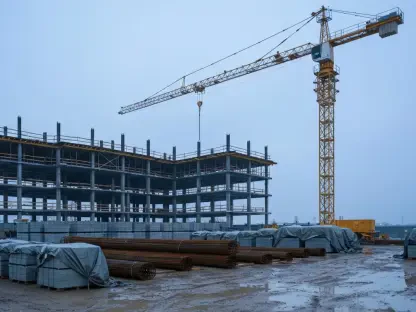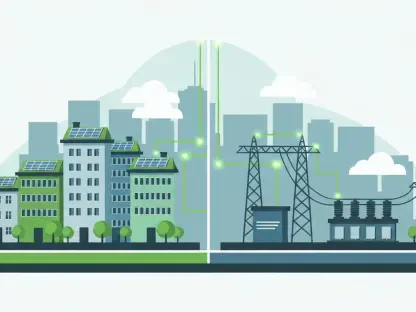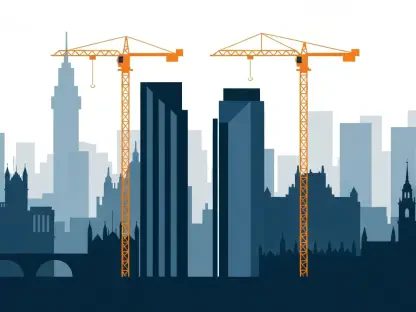Luca Calarailli is a seasoned expert in the construction field, renowned for his insights into design, architecture, and the integration of cutting-edge technology to drive innovation. With extensive experience, Luca sheds light on new policies aimed at transforming the infrastructure sector. In this interview, Luca offers his perspective on the recent mandate for federal agencies to embrace technological advancements in their workflows, the impact on various projects, and the broader implications for industry stakeholders.
What prompted the decision to require federal agencies to integrate technology into their review workflows?
The push to integrate technology into federal agencies’ review workflows stems from the urgent need to expedite infrastructure projects. Over the years, the permitting process has been riddled with inefficiencies, largely due to outdated methods. The primary objective is to modernize these processes, ensuring faster completion times and reducing unnecessary delays. The decision reflects the administration’s commitment to leveraging technology for streamlining operations and enhancing the overall efficiency of infrastructure development.
Can you explain the main goals of the April 15 memorandum?
The April 15 memorandum focuses on several key goals. Firstly, it aims to transition from traditional paper-based applications to digital systems, significantly accelerating the review process. This digitization effort is expected to foster better coordination among agencies and provide project sponsors with greater transparency and predictability concerning project timelines. Ultimately, the goal is to eliminate bottlenecks and unnecessary delays, enabling the completion of crucial infrastructure projects more swiftly and effectively.
What steps are involved in creating the Permitting Technology Action Plan?
Creating the Permitting Technology Action Plan involves a structured approach. Initially, agencies are required to assess their current workflows and identify areas where technology can be integrated to enhance efficiency. Collaboration is a cornerstone of this plan, with the Council on Environmental Quality and the National Energy Dominance Council consulting closely to develop the action plan. The plan will outline specific technological tools and methodologies to be implemented, ensuring a seamless transition to digitized workflows within the designated timeframe.
How do you envision agencies adapting to this new technology within the 45-day timeframe?
Adapting to this new technology within a 45-day window is undoubtedly ambitious, but achievable with focused effort. Agencies will likely conduct intensive training sessions for their staff to familiarize them with the new tools and systems. There might also be a phase where pilot projects are undertaken to test the efficiency and effectiveness of these technological solutions. It’s essential that agencies prioritize this adaptation process to meet the deadlines and pave the way for streamlined operations.
How will this memo specifically impact the review process for infrastructure projects like roads and bridges?
The memo will significantly impact the review process for infrastructure projects such as roads and bridges by expediting the overall timeline. Digital systems will allow for faster submission and review of applications, reducing the lag time commonly associated with paper-based procedures. Enhanced coordination among agencies will ensure that project assessments are conducted more collaboratively, speeding up approvals and enabling quicker commencement of construction activities.
Will the changes be applied uniformly across different types of projects, such as power plants and factories?
While the changes aim for uniform application across various projects, it’s likely that some sectors will experience a more substantial impact than others. For example, projects involving power plants and factories might require specialized processes due to their complexity and environmental implications. However, the overarching goal is to implement these changes uniformly to create a streamlined permitting landscape across all types of infrastructure projects.
What are the challenges in transitioning from a paper-based application system to a digital one?
Transitioning from a paper-based to a digital application system presents several challenges. Firstly, there is the issue of adapting to new technological platforms and ensuring all stakeholders are adequately trained. Data security and privacy concerns also need to be addressed to safeguard sensitive information. Additionally, there might be initial resistance to change, as individuals accustomed to traditional methods may find it challenging to embrace new digital systems. Overcoming these hurdles requires comprehensive planning and effective change management strategies.
How will this transition improve efficiency in environmental reviews?
The transition to digital systems will improve efficiency in environmental reviews by streamlining the submission and assessment processes. Automated tools can quickly analyze data and flag potential issues, reducing the time needed for manual reviews. Enhanced interagency collaboration facilitated by these digital systems will ensure more comprehensive and coherent evaluations, ultimately leading to faster and more reliable environmental assessments.
Can you describe the role of the new Permitting Innovation Center?
The Permitting Innovation Center will play a pivotal role in driving technological adoption and innovation within the permitting process. It will be tasked with developing prototype tools that agencies can use to streamline their workflows. Additionally, the center will serve as a hub for interagency coordination, ensuring that best practices are shared and implemented across various departments. Its role is crucial in fostering a culture of continuous improvement and technological advancement within the infrastructure sector.
How will the center improve coordination and communication between agencies?
The Permitting Innovation Center will enhance coordination and communication by acting as a central repository for information and technological tools. Agencies can access shared resources, enabling more efficient collaboration and reducing duplicative efforts. The center will also facilitate regular meetings and workshops, promoting a unified approach to project assessments and approvals. Such improved coordination will streamline processes, reduce project delays, and foster greater transparency and accountability.
What does Secretary Doug Burgum mean by “innovating faster than our global competitors”?
Secretary Doug Burgum’s statement emphasizes the importance of staying ahead in the global race for technological innovation. By integrating advanced technologies into the permitting process, the goal is to expedite infrastructure projects more effectively than other nations. This innovation not only speeds up project completions but also enhances the overall competitiveness of the country’s infrastructure development capabilities, putting the nation at the forefront of global construction and engineering advancements.
How will the new permitting process support advancements in domestic drilling and mining?
The new permitting process will support advancements in domestic drilling and mining by streamlining the approval processes for these projects. Faster permits mean that companies can commence operations more quickly, facilitating exploration and extraction activities. Additionally, improved transparency and predictability in the permitting timeline will encourage investment in these sectors, driving technological innovation and operational efficiency in drilling and mining endeavors.
How will this order balance the need for faster permits with environmental protection?
Balancing the need for faster permits with environmental protection is a critical aspect of the memorandum. The integration of technology allows for more thorough and efficient environmental reviews, ensuring that projects adhere to strict regulatory standards. By digitizing processes, agencies can quickly identify and mitigate potential environmental impacts, harmonizing the urgency for project completion with the necessity of safeguarding ecosystems and public health.
Have there been any concerns raised by environmental groups about this memorandum?
Environmental groups have indeed raised concerns about the memorandum, particularly regarding the potential risks of accelerating permits for fossil fuel projects. There is apprehension that faster reviews might compromise the thoroughness of environmental assessments, potentially leading to adverse ecological impacts. These groups emphasize the importance of maintaining rigorous scrutiny to ensure that expedited processes do not undermine environmental protections.
How have contractors like AECOM reacted to these changes in the permitting process?
Contractors such as AECOM have shown optimism towards these changes, recognizing the potential for increased project velocity and reduced administrative bottlenecks. By accelerating the permitting process, contractors can expect a more predictable project timeline, which aids in better planning and allocation of resources. This optimism reflects a broader industry sentiment that streamlined processes will drive growth and operational efficiency.
What are the anticipated benefits for contractors if environmental permitting reforms accelerate projects?
Accelerated environmental permitting reforms offer multiple benefits for contractors. Firstly, shorter approval times mean quicker project initiation, leading to faster completion and revenue generation. Enhanced predictability and transparency in the permitting process allow for more precise planning and resource management. Lastly, simplified procedures reduce administrative burdens, enabling contractors to focus more on project execution and innovation.
How did the Biden administration’s policies around permitting differ from those enacted by Trump?
The Biden administration’s policies around permitting diverged significantly from those of Trump, primarily in their focus. While Trump emphasized expediting permits for fossil fuel projects, Biden pushed for faster approvals for clean energy initiatives like wind and solar projects. Although Biden rolled back several of Trump’s changes, his administration maintained the momentum of streamlining processes, albeit with an environmental sustainability focus.
What are the potential economic impacts of speeding up the permitting process for both fossil fuel and clean energy projects?
Speeding up the permitting process for both fossil fuel and clean energy projects can have profound economic impacts. It can stimulate job creation and boost investment in critical infrastructure sectors. Quicker project timelines result in faster economic benefits, enhancing national energy security and reducing dependency on imports. Moreover, faster clean energy projects drive innovation and sustainability, positioning the nation as a leader in renewable energy.
What are the long-term goals for these permitting reforms?
The long-term goals for these permitting reforms revolve around creating a more efficient, transparent, and predictable system for infrastructure development. By integrating advanced technology, the aim is to foster continuous improvement in project assessments and approvals. These reforms intend to bolster national competitiveness, drive economic growth, and ensure environmental sustainability, ultimately setting a robust foundation for future infrastructure and energy independence.
How will this initiative shape the future of American infrastructure and energy independence?
This initiative will profoundly shape the future of American infrastructure and energy independence by laying the groundwork for faster, more efficient project execution. Enhanced digital systems will streamline operations, driving innovation and competitiveness. As a result, the nation will witness accelerated development of critical infrastructure projects across sectors, fostering economic growth and energy self-sufficiency. The initiative reflects a forward-thinking approach that aligns technological advancements with strategic national interests.









